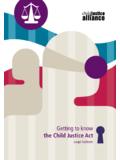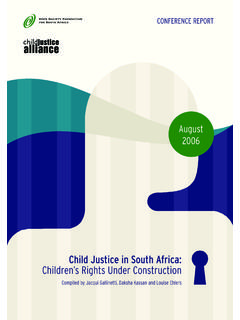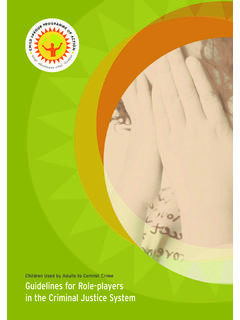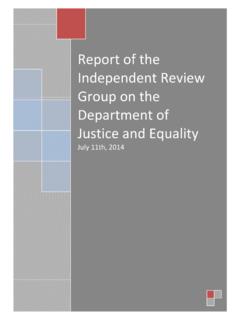Transcription of REVIEW OF SOUTH AFRICAN INNOVATIONS IN ... - Child Justice
1 REVIEW OF SOUTH AFRICAN INNOVATIONS IN DIVERSION ANDREINTEGRATION OF AT-RISK YOUTHA study commissioned by the Criminal Justice Initiative of the Open Society Foundation for SOUTH AfricaCompiled by Francois SteynCentre for Health Systems Research & Development University of the Free StateThe REVIEW team (University of the Free State):Francois Steyn (Centre for Health Systems Research & Development)Herma Foster (Department of Criminology)Deidre Grieshaber (Centre for Development Support)Hlengiwe Hlope (Centre for Health Systems Research & Development)Prof. Lucius Botes (Centre for Development Support)Prof. Dingie van Rensburg (Centre for Health Systems Research & Development)OPEN SOCIETY FOUNDATION FOR SOUTH AFRICAP ublished by the Open Society Foundation for SOUTH Africa,Colinton House, The Oval, 1 Oakdale Road, Newlands 7700, SOUTH 2005 Open Society Foundation for SOUTH AfricaFirst published 2005 All rights 1-920051-18-XPicture credits: Cover: Cedric (top).
2 David (bottom)Part and chapter openers: Ken Oosterbroek/PictureNET AfricaTypeset by Stacey GibsonProduced by Compress 1: INTRODUCTION1 PART 1: COMMUNITY, FAMILY AND VICTIM-FOCUSED PROGRAMMESC hapter 2: Family group conferencing: The Restorative Justice Centre31 Chapter 3: Guardianship and family group conferencing: Othandweni40 Chapter 4: Pre-trial Community Service: National Institute for Crime Prevention and Reintegration of Offenders (NICRO)54 PART 2: LIFE SKILLS TRAINING PROGRAMMESC hapter 5: New Directions: Khulisa Child Nurturing Organisation73 Chapter 6: The youth Empowerment Scheme (YES): National Institute for Crime Prevention and Reintegration of Offenders (NICRO)83 Chapter 7: The Noupoort youth and Community Development Project (NYCDP)90 Chapter 8: Izingwe Kubumbano ( the gathering of the leopards ): Ekupholeni Mental Health Centre103 Chapter 9: SOUTH AFRICAN Young Sex Offenders Programme (SAYStOP)114 PART 3: EXPRESSIVE PROGRAMMESC hapter 10: Diversion into Music Education (DIME)135 Chapter 11: Drama therapy: The Restorative Justice Centre147 Chapter 12: Zimiseleni ( be confident )/Ghetto Boyz Research and Intervention (Ekupholeni Mental Health Centre)152 PART 4: OUTDOOR EXPERIENTIAL PROGRAMMES Chapter 13: Ecotherapy: The National Peace Accord Trust167 Chapter 14: Siyavuka: Educo Africa183 Chapter 15: The Outward Bound Trust of SOUTH Africa193 Chapter 16: The Journey.
3 National Institute for Crime Prevention and Reintegration of Offenders (NICRO)209 PART 5: MENTORING PROGRAMMESC hapter 17: Big Brothers Big Sisters of SOUTH Africa223 PART 6: REINTEGRATION PROGRAMMESC hapter 18: Tough Enough Programme: National Institute for Crime Prevention and Reintegration of Offenders (NICRO)247 Chapter 19: Reintegration and Diversion for youth : The President s Award for youth Empowerment256 Chapter 20: Discovery and Destinations: Khulisa Child Nurturing Services272 CHAPTER 21: CONCLUSION281vACKNOWLEDGEMENTSWe wish to thank the directors, managers, programme officers, magistrates, prosecutors, social workers, probationofficers, trainers, facilitators, volunteers and young beneficiaries of the following organisations, institutions andstructures for generously sharing their knowledge, views and expertise.
4 Big Brothers Big Sisters SOUTH AfricaBosasa youth CentresChildlineCommunity Law Centre, University of the Western CapeDepartment of Criminology, University of SOUTH AfricaDepartment of English, Rhodes UniversityDiversion into Music EducationDepartment of Psychology, University of the Western CapeDepartments of Justice , Correctional Services, Education, Social Development/Services, and Sports andRecreation (Free State, Western Cape, Northern Cape, Eastern Cape and Gauteng)Drug WiseEduco AfricaEkhupoleni Mental Health CentreHealth and Development AfricaInstitute of Criminology, University of Cape TownKhanya Family CentreKhulisa Child Nurturing OrganisationPresident s Award for youth DevelopmentMetropolitan Evangelical Service/Middestad Evangeliese SorgNational Institute for Crime Prevention and Reintegration of OffendersNational Peace Accord TrustNoupoort youth and Community Development ProjectOthandweniOutward Bound Trust of SOUTH AfricaRAPCAN (Resources Aimed at the Prevention of Child Abuse and Neglect)
5 Reception, Assessment and Referral CentreRestorative Justice CentreSabelani Life Skills ProjectSouth AFRICAN Young Sex Offenders ProgrammeSouth AFRICAN Police ServiceYouth Development OutreachTswane Justice AllianceWe extend our gratitude to Prof. Andy Dawes (Human Sciences Research Council: Child , youth and FamilyDevelopment) and Louise Ehlers (Open Society Foundation for SOUTH Africa) for the guidance and insight theyprovided, and we acknowledge the valued work of research assistants Olivia Spies, Gloria Moabi, Lineo Manong,Precious Mokheseng and Vicky OF ACRONYMS AND ABBREVIATIONSABETA dult Basic Education and TrainingBBBSSABig Brothers Big Sisters of SOUTH AfricaCJBC hild Justice BillCLCC ommunity Law CentreDIMED iversion into Music EducationDoCSDepartment of Correctional ServicesDoEDepartment of EducationDoHDepartment of HealthDoSD/DoSSDepartment of Social Development/Department of Social ServicesFGCF amily Group Conference/ConferencingIMCI nter-ministerial Committee on Young Peopleat RiskMESM etropolitan Evangelical Services/MiddestadEvangeliese SorgNAGN etwork Action GroupNCPSN ational Crime Prevention StrategyNICRON ational Institute for Crime Prevention andReintegration of OffendersNPATN ational Peace Accord
6 TrustNYCDPN oupoort youth and Community DevelopmentProjectOBT-SAOutward Bound Trust of SOUTH AfricaOSF-SAOpen Society Foundation for SOUTH AfricaPTCSPre-trial Community ServiceRAPCANR esources Aimed at the Prevention of Child Abuse and NeglectRAURand Afrikaans University (now University of Johannesburg)READYR eintegration and Diversion for YouthRJCR estorative Justice CentreSALRCS outh AFRICAN Law Reform Commission(known previously as the SOUTH AFRICAN Law Commission SALC)SANCAS outh AFRICAN National Council on Alcoholismand Drug DependenceSAPSS outh AFRICAN Police ServicesSAQAS outh AFRICAN Qualifications AuthoritySAYStOPSouth AFRICAN Young Sex Offenders ProjectSDU/SPUSelf-defence Unit/Self-protection UnitTEPT ough Enough ProgrammeTJAT swane Justice AllianceTPAThe President's Award for YouthEmpowermentUCTU niversity of Cape TownUFSU niversity of the Free StateUNISAU niversity of SOUTH AfricaUWCU niversity of the Western CapeVOCV ictim Offender ConferenceYDOY outh Development OutreachYESY outh Empowerment Schemevi111 INTRODUCTIONC ontext of the REVIEW SOUTH Africa has one of the highest recorded crime rates in the world.
7 Although these rates in general appear tobe decreasing, crime in this country nevertheless continues to threaten the personal safety, socio-emotional healthand economic upliftment of its citizens, particularly those living in poor and criminogenic environments(environments conducive to crime). Children and youth are recognised as being a particularly vulnerable group, both as victims and perpetrators ofcrime. In SOUTH Africa, it is estimated that 3 593 children under the age of 18 were in prison as at 31 May 2004,while 1 868 were awaiting trial and 1 725 were serving sentences (Sloth-Nielsen 2004:3). The Child Justice Bill,first tabled in Parliament in August 2002, is aimed at protecting the rights of children accused of committingcrimes and managing their progress through the criminal Justice system.
8 (At the time of writing this legislationhad not been passed.)Diversion is a very important part of this proposed new legislation. Diversion is the process of referring childrenunder the age of 18 who have committed offences, and where there is enough evidence to prosecute, away fromformal criminal Justice proceedings (Sloth-Nielsen and Gallinetti 2004:32). It is important to note here that manyof the programmes in this REVIEW cater for children deemed to be at risk who may not have been arrested forcommitting an offence or referred to the programmes through the formal criminal Justice system. Also, while theChild Justice Bill defines a Child as being under the age of 18, some programmes accommodate young people overthe age of 18 where this is deemed appropriate.
9 Although there is as yet no legal framework, it is estimated that currently some 18 000 children are neverthelessbeing diverted away from the criminal Justice system annually and that this number will increase dramatically oncethe Bill is enacted (Muntingh 2004). The number of diversion services has increased significantly over the past fewyears but there are still not enough of them to cope with the 1999, the Open Society Foundation for SOUTH Africa (OSF-SA), through its Criminal Justice Initiative (CJI),has focused on promoting sound legislation and human rights in the context of the criminal Justice system andcrime prevention (OSF-SA 2004). In its work with children in the criminal Justice system it has sought toinstitutionalise legal and policy frameworks that will protect their rights.
10 To this end, OSF-SA has provided fundsto various initiatives that develop and pilot diversion and reintegration programmes for at-risk youth . Theseinitiatives vary as to when and where they intervene, what strategies they use, and how they interpret the conceptsof restorative Justice and diversion. In 2003, OSF-SA asked the Centre for Health Systems Research & Development, in collaboration with the Centrefor Development Support and the Department of Criminology (University of the Free State) to REVIEW theprogrammes of twelve selected initiatives that provide youth diversion and reintegration services in SOUTH purpose of the REVIEW was to look at the various INNOVATIONS these programmes had introduced, profile eachmodel, study how it affected its intended beneficiaries, and provide an easy reference to a range of programmes forthose working with youth at risk.
















